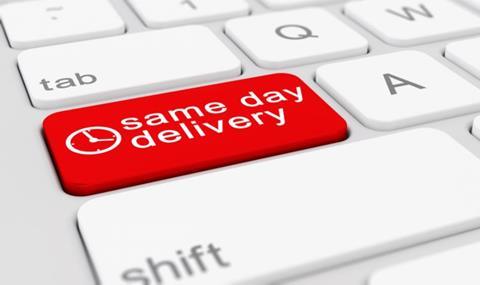
Research from home delivery specialist ParcelHero reveals that 56% of online shoppers rate the option of same-day delivery as important, up from just 33% in 2020.
The research also shows that 62% of consumers expect next-day delivery options, up from 44% in 2020, and 55% want specific, two-hour time slots, compared to 44% in 2020.
ParcelHero’s head of consumer research, David Jinks, said the survey shows shoppers increasingly want stores to offer the same-delivery options as Amazon Prime.
“Online shoppers have dramatically changed their expectations. This is a dramatic rise in online customers’ expectations. Prior to the pandemic, most online purchases were for non-essential items such as entertainment products and electronics.”
Jinks said commensurate with this rise in online shopping is a greater expectation of same-day delivery services.
“Consumers now want to have all their shopping – luxury items as well as household essentials – delivered on the same day.
"The problem for most retailers is that same-day deliveries are vastly more expensive to fulfil than next-day services. Although 64% of shoppers said they are willing to pay more for same-day deliveries, it’s unlikely this would cover the upfront cost of the huge changes in supply chains and distribution centres needed.”
Jinks warned that growing demand for same day deliveries is not only driving up congestion and emissions but could also threaten smaller retailers that do not have the resources to access to a national delivery network.
He added that the same-day delivery boom is also stretching the warehouse management systems (WMS) retailers use which have been designed to deal with deliveries ranging from two weeks to next day, and driving up costs.
“WMS systems can group orders and deal with them in batches – ideal for processing orders overnight. In contrast, same-day orders give just a one or two-hour window. Delivery batch sizes have to be reduced, with smaller order pools. Picks can’t be grouped and optimised in the same way that they can for next-day deliveries, which means higher costs per unit.
"To make same-day delivery economically viable, firms need high and consistent volumes of daily orders within a reasonable radius of their distribution hub. Having vans travel miles to deliver just one or two items to a particular area isn’t viable. For many retailers, that means fulfilling their orders is impossible.”
He added that the same-day delivery demand is driving consolidation in some quarters. “It’s one of the reasons why the delivery giant DPD last week finalised the takeover of courier network CitySprint, which specialises in same-day services," he said.
“DPD says same-day delivery is one of the fastest-growing segments of the logistics market and the deal enables it to provide a range of new delivery options.”













